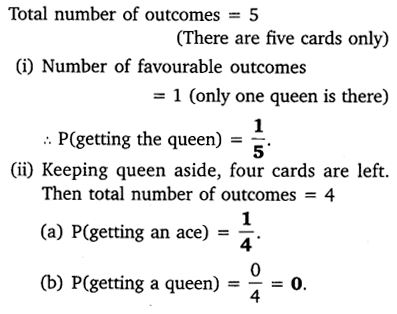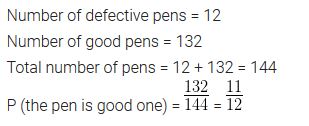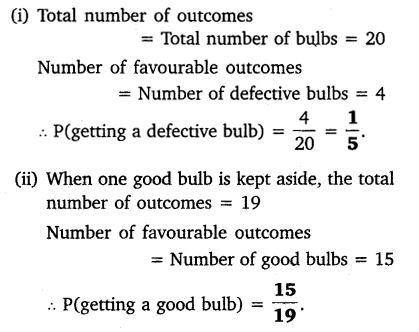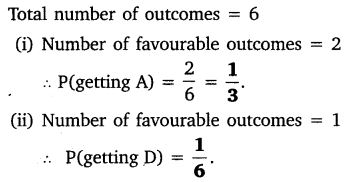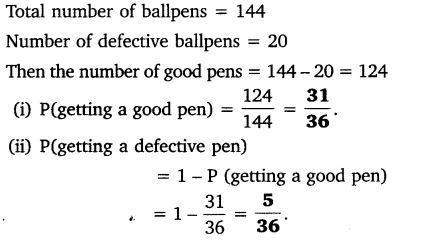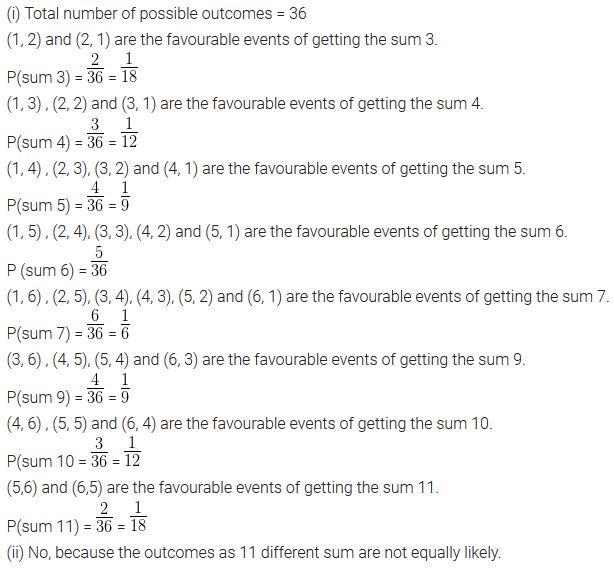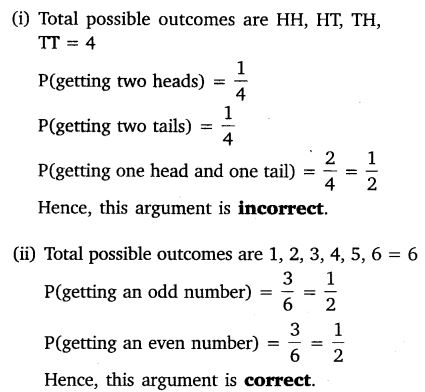Exercise 15.1
Question 1:
Complete the following statements:
(i) Probability of an event E + Probability of the event ‘not E’ = _______.
(ii) The probability of an event that cannot happen is _________. Such as event is called
_________.
(iii) The probability of an event that is certain to happen is _________. Such as event is
called ________.
(iv) The sum of the probabilities of all the elementary events of an experiment is
_________.
(v) The probability of an event is greater than or equal to _______ and less than or equal
to _______.
Answer:
(i) 1
(ii) 0, impossible event
(iii) 1, sure event or certain event
(iv) 1
(v) 0, 1
Question 2:
Which of the following experiments have equally likely outcomes? Explain.
(i) A driver attempts to start a car. The car starts or does not start.
(ii) A player attempts to shoot a basketball. She/he shoots or misses the shot.
(iii) A trial is made to answer a true-false question. The answer is right or wrong.
(iv) A baby is born. It is a boy or a girl
Answer:
(i) It is not an equally likely event, as it depends on various factors such as whether the
car will start or not. And factors for both the conditions are not the same.
(ii) It is not an equally likely event, as it depends on the player’s ability and there is no
information given about that.
(iii) It is an equally likely event.
(iv) It is an equally likely event.
Question 3:
Why is tossing a coin considered to be a fair way of deciding which team should get the
ball at the beginning of a football game?
Answer:
When we toss a coin, the possible outcomes are only two, head or tail, which are equally
likely outcomes. Therefore, the result of an individual toss is completely unpredictable.
Question 4:
Which of the following cannot be the probability of an event?
(A) 2/3 (B) -1.5 (C) 15% (D) 0.7
Answer:
Probability of an event (E) is always greater than or equal to 0. Also, it is always less than
or equal to one. This implies that the probability of an event cannot be negative or
greater than 1. Therefore, out of these alternatives, −1.5 cannot be a probability of an
event.
so our answer is (B) (B is not probability of an event )
Question 5:
If P(E) = 0.05, what is the probability of ‘not E’?
Answer:
We know that,
P(Ē) = 1-P(E)
P(Ē) = 1-0.05
P(Ē) =0.95
therefore , the probability of 'not E' is 0.95..
Question 6:
A bag contains lemon flavoured candies only. Malini takes out one candy without
looking into the bag. What is the probability that she takes out
(i) an orange flavoured candy?
(ii) a lemon flavoured candy?
Answer:
(i) The bag contains lemon flavoured candies only. It does not contain any orange
flavoured candies. This implies that every time, she will take out only lemon flavoured
candies. Therefore, event that Malini will take out an orange flavoured candy is an
impossible event.
Hence, P (an orange flavoured candy) = 0
(ii)As the bag has lemon flavoured candies, Malini will take out only lemon flavoured
candies. Therefore, event that Malini will take out a lemon flavoured candy is a sure
event.
P (a lemon flavoured candy) = 1
Question 7:
It is given that in a group of 3 students, the probability of 2 students not having the
same birthday is 0.992. What is the probability that the 2 students have the same
birthday?
Answer:
Probability that two students are not having same birthday P ( ) = 0.992
Probability that two students are having same birthday P (E) = 1 − P ( )
= 1 − 0.992
= 0.008
Question 8:
A bag contains 3 red balls and 5 black balls. A ball is drawn at random from the bag.
What is the probability that the ball drawn is (i) red? (ii) not red?
Answer:
(i) Total number of balls in the bag = 8
Probability of getting red ball=`\frac{Number of favourable outcomes}{Number of total Possible outcomes}`
=`\frac3{8}`
(ii) Probability of not getting red ball
= 1 − Probability of getting a red ball
= 1-`\frac3{8}`
=`\frac5{8}`
Question 9:
A box contains 5 red marbles, 8 white marbles and 4 green marbles. One marble is
taken out of the box at random. What is the probability that the marble taken out will be
(i) red? (ii) white? (iii) not green?
Answer:
Total number of marbles = 5 + 8 + 4
= 17
(i)Number of red marbles = 5
Probability of getting red marbles=`\frac{Number of favourable outcomes}{Number of total Possible outcomes}`
=`\frac5{17}`
(ii) Number of white marble=8
Probability of getting white marbles`\frac{Number of favourable outcomes}{Number of total Possible outcomes}`
=`\frac8{17}`
(iii) Number of green marbles=4
Probability of getting green marbles`\frac{Number of favourable outcomes}{Number of total Possible outcomes}`
=`\frac4{17}`
Probability of not getting a green marble=`1-\frac4{17}=\frac{13}{17}`
Question : 10
A piggy bank contains hundred 50 p coins, fifty ₹ 1 coins, twenty ₹ 2 coins and ten ₹ 5 coins. If it is equally likely that one of the coins will fall out when the bank is turned upside down, what is the probability that the coin ?
(i) will be a 50 p coin?
(ii) will not be a ₹ 5 coin?
Solution:
numberof50pcoins=100numberof1₹coins=50numberof2₹coins=20numberof5₹coins=10totalnumberofcoins=180Probabiltyof(50paisacoins)=100180=5090=2545=59Probilityof(not5₹coins)=1−10180=11−10180180−10180=170180=1718
of2₹coins=20n
Question 11.
Gopi buys a fish from a shop for his aquarium. The shopkeeper takes out one fish at random from a tank containing 5 male fish and 8 female fish (see figure). What is the probability that the fish taken out is a male fish?
Solution:
thetotalnumberoffishintank=5+8=13thenumberofmalefishintank=5
theprobabilityofmalefishintankis=513
Question 12.
A game of chance consists of spinning an arrow which comes to rest pointing at one of the numbers 1, 2, 3, 4, 5, 6, 7, 8 (see figure.), and these are equally likely outcomes. What is the probability that it will point at
(i) 8?
(ii) an odd number?
(iii) a number greater than 2?
(iv) a number less than 9?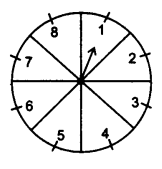
Solution: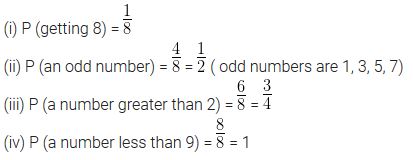
Question 13.
A die is thrown once. Find the probability of getting
(i) a prime number
(ii) a number lying between 2 and 6
(ill) an odd number
Solution: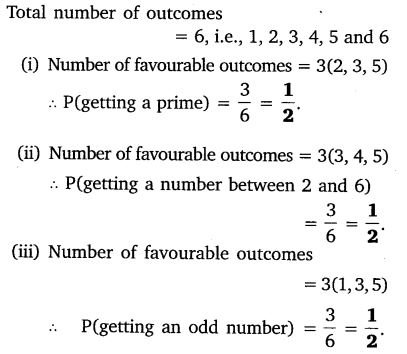
Class 10 Maths Question 14.
One card is drawn from a well-shuffled deck of 52 cards. Find the probability of getting
(i) a king of red colour
(ii) a face card
(iii) a red face card
(iv) the jack of hearts
(v) a spade
(vi) the queen of diamonds
Solution: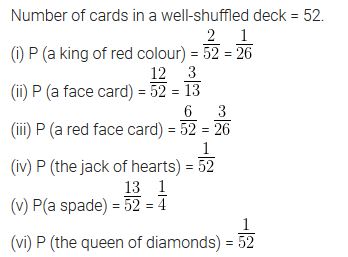
Class 10 Maths Question 15.
Five cards – the ten, jack, queen, king and ace of diamonds, are well shuffled with their face downwards. One card is then picked up at random.
(i) What is the probability that the card is the queen?
(ii) If the queen is drawn and put aside, what is the probability that the second card picked up is
(a) an ace?
(b) a queen?
Solution: